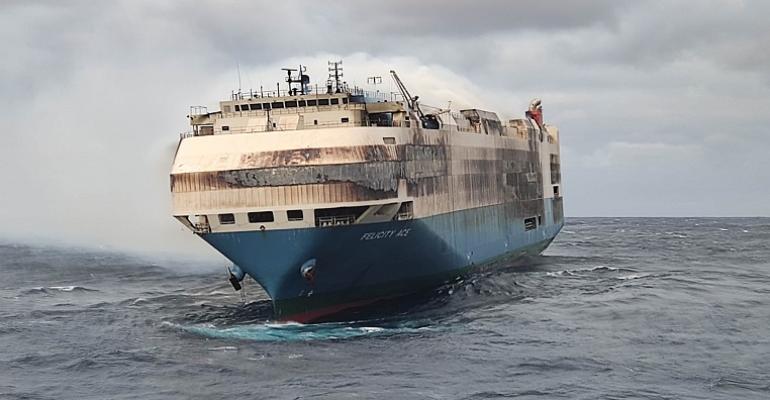The concern around carriage of Electric Vehicles (EVs) and lithium ion (li-ion) batteries is centred around thermal runaway – chemical reactions which can occur in li-ion batteries leading to fire, explosion, and the release of large volumes of toxic gases.
Peregrine Storrs-Fox, Risk Management Director at insurance mutual TT Club said: “Li-ion battery fires are not an everyday occurrence. But when thermal runaway does happen, the result is release of toxic gases such as carbon monoxide and hydrogen cyanide, a very high temperature fire and can spread very fast.”
Li-ion thermal runaway can bring extremely fast increases in temperature, making detection of the early signs of thermal runaway essential. Venting of gases is often the first visible sign of an issue with a li-ion battery, as they are usually located on the underside of a vehicle; those same gases make it dangerous for humans to get close to the failing battery.
The same high temperatures mean li-ion fires are prone to spread very quickly.
Eva Mckiernan, the technical director at firefighting consultancy Jensen Hughes, said that when batteries are damaged, they can release hot and poisonous gases into containers or onto car decks of ro-ro ships and other vehicle carriers within seconds. When the batteries explode, extraordinary temperatures can be reached.
TT Club attended a recent forum in London where interested parties discussed the issue of carrying li-ion batteries and EVs.
“Supply chain players including ship owners, carriers, forwarders, terminal and port operators and insurers are engaged with these debates. Indeed, the maritime regulator IMO (International Maritime Organization) has its guidance for carriage of these batteries under serious review,” said Storrs-Fox.
“But we need to bring manufacturers of EVs and the batteries that power them actively into the debate. Their ambitions for the development of more powerful, lighter, and diverse battery cells must not be allowed to outstrip prioritising safety concerns surrounding their future transportation around the globe.”
While a US National Transportation Safety Board (NTSB) study found that EVs were reported to have incurred fewer fire incidents than internal combustion engine cars, there are fewer EVs on the road and older batteries are more likely to explode than newer ones; as a result, it is not clear how the batteries will perform through the intended life as the adopted of EVs accelerates.
TT Club wants to draw attention to the hazards of shipping li-ion batteries, and bring about a balanced, realistic awareness of the dangers, and a united approach to enhancing their safe carriage, it said.
“Improved regulatory clarity is required and auto manufacturers need to address transport safety issues more thoroughly,” said the club.
“Currently li-ion batteries are classified as one of four UN numbers, depending on power output or the weight of lithium in them and whether they are contained within devices or shipped separately. All four are Class 9 in the IMDG Code - Miscellaneous dangerous substances and articles,” said Storrs-Fox.
“Class 9 is the least hazardous ranking and dates from a change in IMDG Class from 4.3, which was made in the late eighties. Clearly there is a need for a radical review of this classification, as the size and energy capacity of these batteries has altered dramatically since then. As has the volume being carried in container ships.”
The low classification of li-ion batteries impacts their treatment along the supply chain, including in the creation of stowage plans.
“In addressing the commercial opportunity in the answering the agenda to move away from fossil fuels, there needs to be urgent engagement from manufacturers and OEMs to resolve the justifiable concerns of the logistics industry – ahead of regulatory strengthening,” said Storrs-Fox concludes.
Copyright © 2024. All rights reserved. Seatrade, a trading name of Informa Markets (UK) Limited.
Add Seatrade Maritime News to your Google News feed.  |

